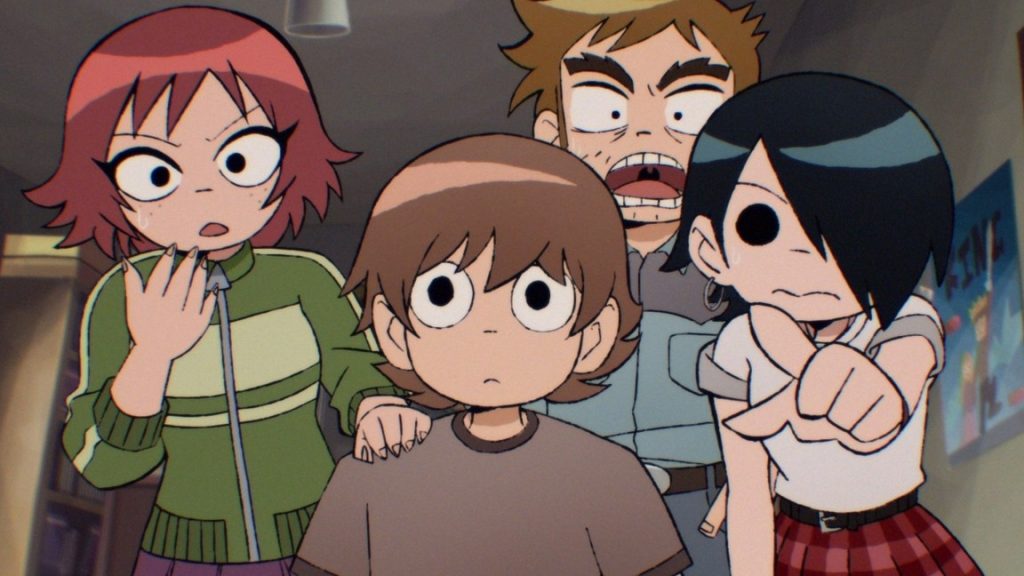The cult classic comic series is adapted with playfulness, imagination, and surprising tenderness as it reimagines the story we think it’s telling.
★★★★☆
When it was announced that Scott Pilgrim was getting an anime series, fans were thrilled but also had no idea what to expect. With original comic book author Bryan Lee O’Malley aboard, alongside BenDavid Grabinski, it was assumed that it would be a straightforward adaptation. In March, Edgar Wright, who adapted the comic into a live-action film in 2010, as well as the entire cast of said film, joined the production, increasing the anticipation even more. The choice of Japanese Studio Science Saru introduced traditional anime sensibilities to the mix, with the initial teaser trailer particularly leaning into video game aesthetics.
However, other than these tidbits, very little was known about the nature of Scott Pilgrim Takes Off. That is until all 8 episodes were simultaneously released on Netflix last Friday, and what arrived on the platform was a joyful reinvention that surpassed all expectations of what the show would be.
The show opens very similarly to its predecessors, introducing us to 23-year-old Toronto bassist, Scott Pilgrim (Michael Cera). Living with his ‘cool, gay, roommate’ Wallace Wells (Kieran Culkin), rocking in his band Sex Bob-Omb, and (sort of) dating 17-year-old High Schooler Knives Chau (Ellen Wong), is all there really is to Scott’s life. That is until he starts dreaming of a rainbow-haired, roller-skating, goggle-wearing woman he immediately falls in love with. It very quickly comes to light that she does in fact exist beyond his dreams, and is none other than Ramona Flowers (Mary Elizabeth Winstead). Meeting at a mutual friend’s party (the snarky Julie Powers, played by Aubrey Plaza), there are immediate sparks between the pair, and it seems that all of Scott’s dreams are coming true, until the revelation that Scott will need to defeat Ramona’s Seven Evil Exes before he can be with her.So goes the first episode of the series, following the Scott Pilgrim narrative we already know and love. That’s until it doesn’t. As the credits roll on episode one, viewers familiar with the story are left in confusion as it veers into an alternative reality. The show uses its following seven episodes to explore a brand new story; one that offers us previously unseen insights into supporting characters, whilst firmly retaining the tone and charm of the franchise.
In doing so, this alternate reality highlights the ways in which the previous iteration was a product of its time: its ‘manic-pixie dream girl’ love interest; its posturing of emotional toxicity as quirky behaviour; and its generally questionable gender dynamics. However, the writing team take this opportunity to resolve these issues, in a way that feels modernised without being forced. Instead of Ramona existing purely as the object of Scott’s desire, here she is given agency as she traverses her own journey to reconcile her past with who she is now. Instead of writing off hurtful behaviours with a gag, the show puts in the work to look at the root of these behaviours and lovingly challenges them – offering the evil exes redemption arcs they were never previously afforded. Female characters like Knives and Kim (Alison Pill) are given their chance to shine, and Scott’s neglect of them is called out for what it is. It doesn’t just serve as revisionist history, however, but there is creativity and hilarity in the expanding scope of this universe.
The choice to partner with a Japanese studio is a huge part of the winning formula of this anime. The animation style brings vivid life to the original drawings on O’Malley’s pages, while also incorporating influences from other anime series and films. The use of flashback sequences throughout drew to mind classic Ghibli films such as Only Yesterday and Whisper of the Heart. This is only aided by music from band Anamanaguchi, whose Japanese and video game influences make them the perfect pairing for this production.

The playfulness of the form is fully utilised, with different episodes going for different approaches. From an episode structured and shot like a documentary, to a day in the life of one of the evil exes, to plays within the series. Even within the episodes, the expanse of creativity feels limitless, from the ‘start’ button below each episode title in its video game stylings to the bold strikes of every fight scene.
That being said, as the episodes go on, the story loses its sense of where it’s going, and as the action becomes more convoluted, one yearns for the simplicity of the original narrative. The sci-fi action renderings are true to the nature of the source material, but the pacing means that they feel shoehorned into the last few episodes, after a series that has felt subversive in its character studies. It’s not as funny as previous iterations, mainly because it tries to be more serious and introspective in its themes. It does remain a riot, however, and brings undeniable joy to anyone watching. Also, the songs are absolute bangers, and the cast is still great, even if it shows which of them have done voice acting before.In the first episode, Scott tries to flirt with Ramona by telling her a story about the two Sonic the Hedgehog shows on air simultaneously in the 90s. One was a standard kids’ comedy, while the other was a grittier take. And yet, the same actor played both these contrasting versions of Sonic. While the use of the story is incredibly on the nose, its inclusion highlights something significant: Takes Off isn’t the Scott Pilgrim you know, but its simultaneous existence with the one you do makes for two complementary works. Both are well worth watching, for their individual merits, but also for what they draw out of each other.
The Verdict
This anime adds profundity to its source material, whilst never losing the silliness that made it special in the first instance and its willingness to play with the possibilities of animation makes it clear that this was the only way to tell this story. Additionally, its building on characters who previously existed as tropes makes the world of Scott Pilgrim all the richer.
Words by Rehana Nurmahi
Support The Indiependent
We’re trying to raise £200 a month to help cover our operational costs. This includes our ‘Writer of the Month’ awards, where we recognise the amazing work produced by our contributor team. If you’ve enjoyed reading our site, we’d really appreciate it if you could donate to The Indiependent. Whether you can give £1 or £10, you’d be making a huge difference to our small team.
